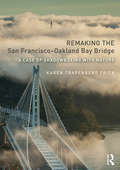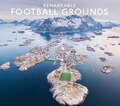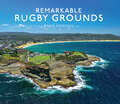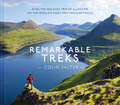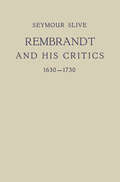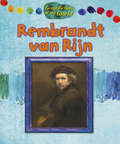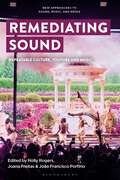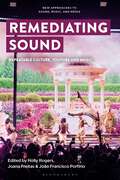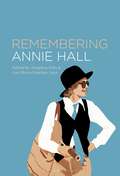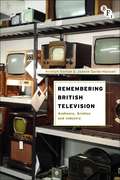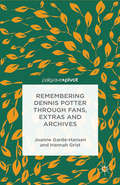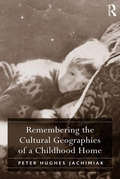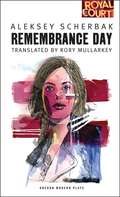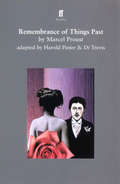- Table View
- List View
Remaking the San Francisco-Oakland Bay Bridge: A Case of Shadowboxing with Nature (Planning, History and Environment Series)
by Karen Trapenberg FrickWinner of TransportiCA’s September Book Club Award 2018 On 17 October 1989 one the largest earthquakes to occur in California since the San Francisco earthquake of April 1906 struck Northern California. Damage was extensive, none more so than the partial collapse of the San Francisco–Oakland Bay Bridge’s eastern span, a vital link used by hundreds of thousands of Californians every day. The bridge was closed for a month for repairs and then reopened to traffic. But what ensued over the next 25 years is the extraordinary story that Karen Trapenberg Frick tells here. It is a cautionary tale to which any governing authority embarking on a megaproject should pay heed. She describes the process by which the bridge was eventually replaced as an exercise in shadowboxing which pitted the combined talents and shortcomings, partnerships and jealousies, ingenuity and obtuseness, generosity and parsimony of the State’s and the region’s leading elected officials, engineers, architects and other members of the governing elites against a collectively imagined future catastrophe of unknown proportions. In so doing she highlights three key questions: If safety was the reason to replace the bridge, why did it take almost 25 years to do so? How did an original estimate of $250 million in 1995 soar to $6.5 billion by 2014? And why was such a complex design chosen? Her final chapter – part epilogue, part reflection – provides recommendations to improve megaproject delivery and design.
Remapping Performance: Common Ground, Uncommon Partners
by Jan Cohen-CruzCompleting a trilogy of works by Jan Cohen-Cruz, Remapping Performance focuses on the work of artists and experts who collaborate across fields to address social issues. The book explores work of a range of artists who employ artistic training, methodologies and mind-sets in their work with experts from other sectors such as medicine and healthcare and from other disciplines, to draw an expanded map of performance platforms including university/ community partnerships, neighbourhood-bases, and cultural diplomacy. Case studies include ArtSpot Productions/Mondo Bizarro's Cry You One about climate change in southern Louisiana, incorporating theatrics and organizing; Michael Rohd/Sojourn Theatre's social and civic practices; Anne Basting's University of Wisconsin-Milwaukee-based integration of performance and creative aging; and the collaborative cultural diplomacy experiment, smARTpower. Short companion pieces add expertise from Helen Nicholson, Todd London, Julie Thompson Klein, Nancy Cantor, Maria Rosario Jackson, and Penny Von Eschen. Jan Cohen-Cruz ends with suggestions for fully integrating performance in cross-sector initiatives. This latest book by a leading figure in engaged/ applied theatre and performance builds on its predecessors by offering a future-oriented perspective, a vision of art and performance interacting with a range of social sectors and with an emphasis on HE in such partnerships, and will be a 'must-read' for all students and scholars working in this field.
Remarkable Football Grounds
by Ryan HermanRemarkable Football Grounds is a collection of some of the most memorable places to watch and play football around the world. They range from the stellar stadiums of the Premier League to windswept islands in the Scottish Hebrides or the far-flung Pacific, including stadia that resemble flying saucers, a crocodile and an armadillo!
Remarkable Rugby Grounds
by Ryan HermanLaunched as rugby hits fever pitch for the 2023 World Cup, Remarkable Rugby Grounds is the perfect title for a literate and affluent armchair rugby market.
Remarkable Treks
by Colin SalterRemarkable Treks is a compendium of exhilarating long-distance walks from around the planet – some lasting weeks, some lasting just a few days, but all of them set against spectacular backdrops.
Rembrandt and His Critics 1630–1730 (Utrechtse bijdragen tot de kunstgeschiedenis #2)
by Seymour SliveRembrandt van Rijn: Rembrandt Van Rijn (Great Artists of the World #6)
by Alix WoodGreat Artists introduces young readers to some of the world's great artists. The books feature easy-to-read text and some of the most famous examples of each artist's work, as well as photographs of places and people of importance.
Rembrandt's Jews
by Steven NadlerThere is a popular and romantic myth about Rembrandt and the Jewish people. One of history's greatest artists, we are often told, had a special affinity for Judaism. With so many of Rembrandt's works devoted to stories of the Hebrew Bible, and with his apparent penchant for Jewish themes and the sympathetic portrayal of Jewish faces, it is no wonder that the myth has endured for centuries. Rembrandt's Jews puts this myth to the test as it examines both the legend and the reality of Rembrandt's relationship to Jews and Judaism. In his elegantly written and engrossing tour of Jewish Amsterdam—which begins in 1653 as workers are repairing Rembrandt's Portuguese-Jewish neighbor's house and completely disrupting the artist's life and livelihood—Steven Nadler tells us the stories of the artist's portraits of Jewish sitters, of his mundane and often contentious dealings with his neighbors in the Jewish quarter of Amsterdam, and of the tolerant setting that city provided for Sephardic and Ashkenazic Jews fleeing persecution in other parts of Europe. As Nadler shows, Rembrandt was only one of a number of prominent seventeenth-century Dutch painters and draftsmen who found inspiration in Jewish subjects. Looking at other artists, such as the landscape painter Jacob van Ruisdael and Emmanuel de Witte, a celebrated painter of architectural interiors, Nadler is able to build a deep and complex account of the remarkable relationship between Dutch and Jewish cultures in the period, evidenced in the dispassionate, even ordinary ways in which Jews and their religion are represented—far from the demonization and grotesque caricatures, the iconography of the outsider, so often found in depictions of Jews during the Middle Ages and the Renaissance. Through his close look at paintings, etchings, and drawings; in his discussion of intellectual and social life during the Dutch Golden Age; and even through his own travels in pursuit of his subject, Nadler takes the reader through Jewish Amsterdam then and now—a trip that, under ever-threatening Dutch skies, is full of colorful and eccentric personalities, fiery debates, and magnificent art.
Rembrandt's Roughness
by Nicola SuthorRoughness is the sensual quality most often associated with Rembrandt's idiosyncratic style. It best defines the specific structure of his painterly textures, which subtly capture and engage the imagination of the beholder. Rembrandt's Roughness examines how the artist's unconventional technique pushed the possibilities of painting into startling and unexpected realms.Drawing on the phenomenological insights of Edmund Husserl as well as firsthand accounts by Rembrandt's contemporaries, Nicola Suthor provides invaluable new perspectives on many of the painter's best-known masterpieces, including The Anatomy Lesson of Dr. Deyman, The Return of the Prodigal Son, and Aristotle with a Bust of Homer. She focuses on pictorial phenomena such as the thickness of the paint material, the visibility of the colored priming, and the dramatizing element of chiaroscuro, showing how they constitute Rembrandt's most effective tools for extending the representational limits of painting. Suthor explores how Rembrandt developed a visually precise handling of his artistic medium that forced his viewers to confront the paint itself as a source of meaning, its challenging complexity expressed in the subtlest stroke of his brush.A beautifully illustrated meditation on a painter like no other, Rembrandt's Roughness reflects deeply on the intellectual challenge that Rembrandt's unrivaled artistry posed to the art theory of his time and its eminent role in the history of art today.
Rembrandt's Roughness
by Nicola SuthorRoughness is the sensual quality most often associated with Rembrandt's idiosyncratic style. It best defines the specific structure of his painterly textures, which subtly capture and engage the imagination of the beholder. Rembrandt's Roughness examines how the artist's unconventional technique pushed the possibilities of painting into startling and unexpected realms.Drawing on the phenomenological insights of Edmund Husserl as well as firsthand accounts by Rembrandt's contemporaries, Nicola Suthor provides invaluable new perspectives on many of the painter's best-known masterpieces, including The Anatomy Lesson of Dr. Deyman, The Return of the Prodigal Son, and Aristotle with a Bust of Homer. She focuses on pictorial phenomena such as the thickness of the paint material, the visibility of the colored priming, and the dramatizing element of chiaroscuro, showing how they constitute Rembrandt's most effective tools for extending the representational limits of painting. Suthor explores how Rembrandt developed a visually precise handling of his artistic medium that forced his viewers to confront the paint itself as a source of meaning, its challenging complexity expressed in the subtlest stroke of his brush.A beautifully illustrated meditation on a painter like no other, Rembrandt's Roughness reflects deeply on the intellectual challenge that Rembrandt's unrivaled artistry posed to the art theory of his time and its eminent role in the history of art today.
Remediating Sound: Repeatable Culture, YouTube and Music (New Approaches to Sound, Music, and Media)
by Holly Rogers, Joana Freitas and João Francisco PorfírioRemediating Sound studies the phenomena of remixing, mashup and recomposition: forms of reuse and sampling that have come to characterise much of YouTube's audiovisual content. Through collaborative composition, collage and cover songs to reaction videos and political activism , users from diverse backgrounds have embraced the democratised space of YouTube to open up new and innovative forms of sonic creativity and push the boundaries of audiovisual possibilities. Observing the reciprocal flow of influence that runs between various online platforms, 12 chapters position YouTube as a central hub for the exploration of digital sound, music and the moving image. With special focus on aspects of networked creativity that remain overlooked in contemporary scholarship, including library music, memetic media, artificial intelligence, the sonic arts and music fandom, this volume offers interdisciplinary insight into contemporary audiovisual culture.
Remediating Sound: Repeatable Culture, YouTube and Music (New Approaches to Sound, Music, and Media)
Remediating Sound studies the phenomena of remixing, mashup and recomposition: forms of reuse and sampling that have come to characterise much of YouTube's audiovisual content. Through collaborative composition, collage and cover songs to reaction videos and political activism , users from diverse backgrounds have embraced the democratised space of YouTube to open up new and innovative forms of sonic creativity and push the boundaries of audiovisual possibilities. Observing the reciprocal flow of influence that runs between various online platforms, 12 chapters position YouTube as a central hub for the exploration of digital sound, music and the moving image. With special focus on aspects of networked creativity that remain overlooked in contemporary scholarship, including library music, memetic media, artificial intelligence, the sonic arts and music fandom, this volume offers interdisciplinary insight into contemporary audiovisual culture.
Remembering: Oral History Performance (Palgrave Studies in Oral History)
by Jacquelyn Dowd HallDrawing on the work of scholars and practitioners such as Augusto Boal, Gloria Anzaldua, and Trinh Minh-ha, these essays advocate oral history and oral history-based performance as means to challenge and expand upon traditional ways of transmitting historical knowledge. The contributors' central concerns are performative aspects of oral history itself and the theatrical or classroom "re-performance" of oral history. The essays detail classroom and public pedagogies, community-based interventions, processes of developing interview-based performances, and the ethical and political implications of oral history as an embodied form of representation. The essays collected in this volume present the most current scholarship straddling the rich intersection between oral history and performance, and together suggest ways for scholars and performers to use oral history to challenge more traditional modes of knowledge.
Remembering Annie Hall
by Jonathan Ellis and Ana María Sánchez-ArceSince its release, Annie Hall has established itself as a key film for Woody Allen's career and the history of romantic comedy more generally. At the 1978 Academy Awards, it won Oscars for Best Film, Best Director, Best Screenplay, and Best Actress and is regularly cited as one of the greatest film comedies ever released, credited with influencing directors such as Wes Anderson, Noah Baumbach, Richard Linklater, Greta Gerwig and Desiree Akhavan. This lively collection brings a new ethical and philosophical perspective to bear on Allen's work quite different from previous generations of scholars.At the same time as exploring the film's continuing influence on contemporary cinema, this book's contributors engage explicitly and implicitly with ongoing debates about Allen's cinematic output following the renewal of accusations against Allen by his adopted daughter Dylan Farrow in 2014 and 2018. The book is alive to debates within film studies about the limits of auteur theory and the role of the spectator.
Remembering Annie Hall
Since its release, Annie Hall has established itself as a key film for Woody Allen's career and the history of romantic comedy more generally. At the 1978 Academy Awards, it won Oscars for Best Film, Best Director, Best Screenplay, and Best Actress and is regularly cited as one of the greatest film comedies ever released, credited with influencing directors such as Wes Anderson, Noah Baumbach, Richard Linklater, Greta Gerwig and Desiree Akhavan. This lively collection brings a new ethical and philosophical perspective to bear on Allen's work quite different from previous generations of scholars.At the same time as exploring the film's continuing influence on contemporary cinema, this book's contributors engage explicitly and implicitly with ongoing debates about Allen's cinematic output following the renewal of accusations against Allen by his adopted daughter Dylan Farrow in 2014 and 2018. The book is alive to debates within film studies about the limits of auteur theory and the role of the spectator.
Remembering British Television: Audience, Archive and Industry
by Kristyn Gorton Joanne Garde-HansenThis original book asks how, in an age of convergence, when 'television' no longer means a box in the corner of the living room that we sit and watch together, do we remember television of the past? How do we gather and archive our memories? Kristyn Gordon and Joanne Garde-Hansen explore these questions through first person interviews with tv producers, curators and archivists, and case studies of popular television series and fan communities such as 'Cold Feet' and 'Doctor Who'. Their discussion takes in museum exhibitions, popular televison nostalgia programming and 'vintage' tv websites.
Remembering British Television: Audience, Archive and Industry
by Kristyn Gorton Joanne Garde-HansenThis original book asks how, in an age of convergence, when 'television' no longer means a box in the corner of the living room that we sit and watch together, do we remember television of the past? How do we gather and archive our memories? Kristyn Gordon and Joanne Garde-Hansen explore these questions through first person interviews with tv producers, curators and archivists, and case studies of popular television series and fan communities such as 'Cold Feet' and 'Doctor Who'. Their discussion takes in museum exhibitions, popular televison nostalgia programming and 'vintage' tv websites.
Remembering Dennis Potter Through Fans, Extras and Archives
by J. Garde-Hansen H. GristAn accessible case study of television heritage, Remembering Dennis Potter Through Fans, Extras and Archive draws on the memories of fans and extras of Potter's productions. In providing insight into issues of visibility, memory and television production, it fulfils a vital need for better understanding of television production history as heritage.
Remembering Places: The Autobiography Of Joseph Rykwert
by Joseph RykwertBorn in Warsaw in 1926, Joseph Rykwert is one of the best-known critics and historians of architecture. One of very few writers to be awarded the RIBA’s highest honour, the Royal Gold Medal, in 2014, and author of countless books and essays, his influence over the past 60 years cannot be underestimated. In this memoir he tells for the first time of how his life’s experiences shaped his working life. He addresses the dualities between which he had to navigate: Jewish/Polish, Polish/British and later, Practice/Scholarship. He spent most of his working life between the US and UK and worked both as a designer and a writer; as such his ground-breaking ideas and work have had a major impact on the thinking of architects and designers since the 1960s and continue to do so to this day.
Remembering Places: A Memoir
by Joseph RykwertBorn in Warsaw in 1926, Joseph Rykwert is one of the best-known critics and historians of architecture. One of very few writers to be awarded the RIBA’s highest honour, the Royal Gold Medal, in 2014, and author of countless books and essays, his influence over the past 60 years cannot be underestimated. In this memoir he tells for the first time of how his life’s experiences shaped his working life. He addresses the dualities between which he had to navigate: Jewish/Polish, Polish/British and later, Practice/Scholarship. He spent most of his working life between the US and UK and worked both as a designer and a writer; as such his ground-breaking ideas and work have had a major impact on the thinking of architects and designers since the 1960s and continue to do so to this day.
Remembering the Cultural Geographies of a Childhood Home
by Peter Hughes JachimiakUsing an innovative auto-ethnographic approach to investigate the otherness of the places that make up the childhood home and its neighbourhood in relation to memory-derived and memory-imbued cultural geographies, Remembering the Cultural Geographies of a Childhood Home is concerned with childhood spaces and children's perspectives of those spaces and, consequentially, with the personalised locations that make up the childhood family home and its immediate surroundings (such as the garden, the street, etc.). Whilst this book is primarily structured by the author's memories of living in his own Welsh childhood home during the 1970s - that is, the auto-ethnographic framework - it is as much about living anywhere amid the remembered cultural remnants of the past as it is immersing oneself in cultural geographies of the here-and-now. As a result, Remembering the Cultural Geographies of a Childhood Home is part of the ongoing pursuit by cultural geographers to provide a personal exploration of the pluralities of shared landscapes, whereby such an engagement with space and place aid our construction of cognitive maps of meaning that, in turn, manifest themselves as both individual and collective cultural experiences. Furthermore, touching upon our co-habiting of ghost topologies, Remembering the Cultural Geographies of a Childhood Home also encourages a critical exploration of children’s spirituality amid the haunted cultural and geographical spaces and places of a house and its neighbourhood: the cellar, hallway, parlour, stairs, bedroom, attic, shops, cemeteries, and so on.
Remembering the Cultural Geographies of a Childhood Home
by Peter Hughes JachimiakUsing an innovative auto-ethnographic approach to investigate the otherness of the places that make up the childhood home and its neighbourhood in relation to memory-derived and memory-imbued cultural geographies, Remembering the Cultural Geographies of a Childhood Home is concerned with childhood spaces and children's perspectives of those spaces and, consequentially, with the personalised locations that make up the childhood family home and its immediate surroundings (such as the garden, the street, etc.). Whilst this book is primarily structured by the author's memories of living in his own Welsh childhood home during the 1970s - that is, the auto-ethnographic framework - it is as much about living anywhere amid the remembered cultural remnants of the past as it is immersing oneself in cultural geographies of the here-and-now. As a result, Remembering the Cultural Geographies of a Childhood Home is part of the ongoing pursuit by cultural geographers to provide a personal exploration of the pluralities of shared landscapes, whereby such an engagement with space and place aid our construction of cognitive maps of meaning that, in turn, manifest themselves as both individual and collective cultural experiences. Furthermore, touching upon our co-habiting of ghost topologies, Remembering the Cultural Geographies of a Childhood Home also encourages a critical exploration of children’s spirituality amid the haunted cultural and geographical spaces and places of a house and its neighbourhood: the cellar, hallway, parlour, stairs, bedroom, attic, shops, cemeteries, and so on.
Remembering the Occupation in French film: National Identity in Postwar Europe (Studies in European Culture and History)
by L. HewittWhen collective memory is a source of national debate, the public representation of history quickly becomes a locus of controversy and ideological struggle. This work shows how French film has allowed for a public airing of current concerns through the lens of memory's recreations of the Occupation.
Remembrance Day (Oberon Modern Plays Ser.)
by Aleksey Scherbak Rory MullarkeyCan you be a hero if you fought for Nazi Germany?The Latvians who fought for the Third Reich and halted the Red Army parade as heroes every year through the streets of Riga. As a growing number of young Russians campaign to halt the 'fascist' march, their Latvian counterparts join the veterans in commemoration. When teenager Anya becomes a political activist, her father's attempts to calm the situation stir up a storm of extremist patriotism. Remembrance Day takes an look at the fight for the political soul of Latvia.
Remembrance of Things Past: Combray (Classics Ser.)
by Monsieur Marcel ProustRecognized as one of the major literary works of the twentieth-century, Marcel Proust's monumental seven-volume novel brings together memories of childhood and Parisian society before and during the First World War.This new adaptation is based on Harold Pinter's screenplay, written at the request of the film director Joseph Losey in 1972.Remembrance of Things Past premièred at the Royal National Theatre in November 2000.
